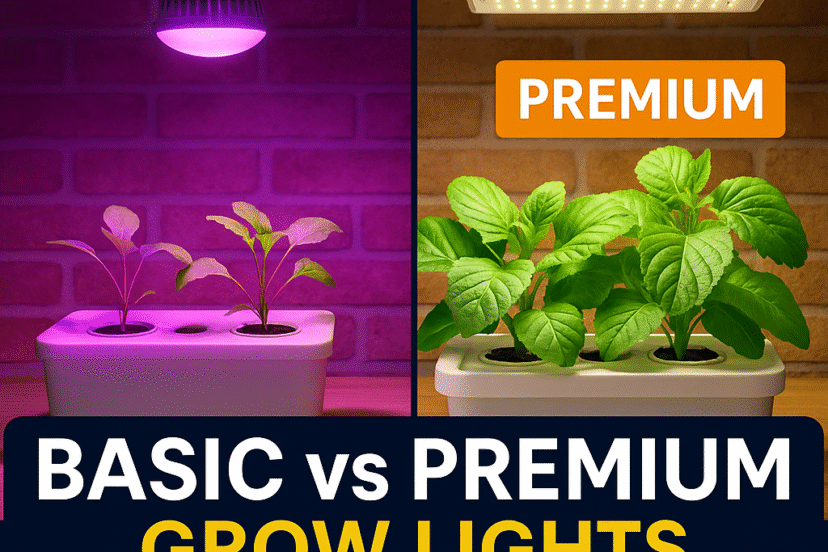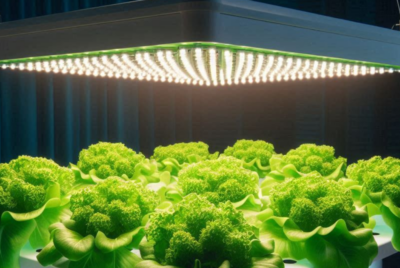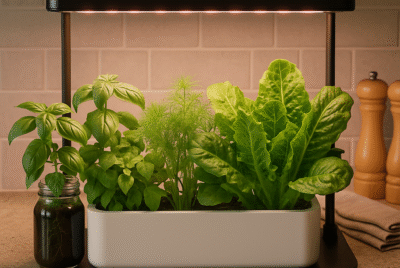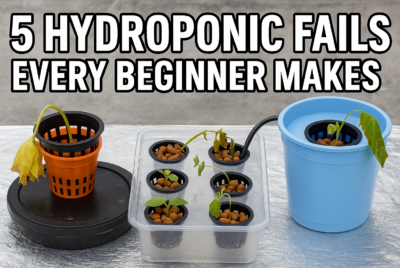Basic vs Premium Grow Lights in Hydroponics
Have you ever set up a hydroponic garden and wondered if your grow light is truly up to the task? Whether you’re a beginner nurturing herbs or an advanced grower optimising yields, lighting is everything. This guide breaks down the differences between basic and premium grow lights—and why they matter.
Why Lighting Is Crucial in Hydroponics
In hydroponics, plants don’t get sunlight—so you’re responsible for providing it. That means choosing a grow light that offers the right intensity, spectrum, and duration to mimic the sun. The quality of your grow light determines how healthy, productive, and fast-growing your plants are.
What Are Basic Grow Lights?
Basic grow lights are entry-level lighting solutions such as:
- Low-cost LED panels (often purple or “blurple”)
- Household LED bulbs with red/blue spectrum
- CFLs or fluorescent tubes like T5s or T8s
They’re budget-friendly and great for small-scale growing like herbs or seedlings—but lack the power and features of more advanced options.
Pros of Basic Grow Lights
- Affordable for beginners
- Easy to install (plug and play)
- Low heat output (safe for small spaces)
Cons of Basic Grow Lights
- Limited PAR output and light coverage
- Fixed spectrum (usually just red/blue)
- Shorter lifespan and durability
Product Example: Sansi 15W LED Grow Bulb
A full-spectrum LED screw-in bulb ideal for desktops or small herb gardens.
- Spectrum: Full white + red/blue
- Coverage: 1–2 small pots
Product Example: Barrina T5 LED Strip (4-Pack)
Budget-friendly T5 strip lights for shelf or seedling racks.
- Spectrum: Daylight 6500K
- Coverage: Ideal for trays or greens
Premium Grow Lights: The Upgrade
Premium grow lights are high-output LEDs designed for serious growers. They offer full-spectrum output, higher PAR, better efficiency, and smart features like dimming, daisy-chaining, and integrated timers.
Pros of Premium Grow Lights
- Excellent PAR intensity and canopy coverage
- Energy-efficient and longer-lasting
- Full-spectrum light supports all growth stages
- Often fanless and silent
- Ideal for fruiting, flowering, or year-round crops
Cons of Premium Grow Lights
- Higher upfront investment
- Can be too intense for seedlings if misused
- Requires careful height and timing management
Product Example: Spider Farmer SF-2000
- Wattage: 200W true draw
- Spectrum: Full-spectrum white with IR and red
- Coverage: Up to 4×2 ft flowering area
- Features: Samsung LM301B diodes, dimmable, fanless
Product Example: Mars Hydro TS-1000
- Wattage: 150W true draw
- Coverage: 3×3 ft for veg, 2×2 ft for flowering
- Spectrum: Full-spectrum with enhanced red
Light Spectrum, PAR, and Plant Biology
Light spectrum matters. Plants use light between 400–700nm for photosynthesis, known as PAR (Photosynthetically Active Radiation). Basic lights often only emit red and blue, while premium grow lights mimic sunlight by adding green, far-red, and sometimes UV.
- Blue (400–500nm): Encourages strong vegetative growth
- Red (600–700nm): Triggers flowering and fruiting
- Green (500–600nm): Penetrates deep into canopy leaves
- Far-red (700–750nm): Enhances bloom and elongation
- UV: Stimulates pigmentation and pest resistance
Premium lights = more usable light, wider spectrum, better yields. Especially important for crops like tomatoes, peppers, cannabis, and cucumbers that need strong light to thrive indoors.
Light Intensity & PAR Output
PAR is measured in µmol/m²/s. This tells us how many light photons hit the plant surface each second. More isn’t always better—but too little stunts growth. Here’s a quick guide:
- Seedlings / Herbs: 100–300 µmol/m²/s
- Leafy Greens: 200–400 µmol/m²/s
- Fruiting Plants: 600–900+ µmol/m²/s
Premium lights usually provide high, even PAR across the canopy, while basic lights drop off fast outside the center. Always check PAR maps from manufacturers to match light to plant needs and grow space size.
Light Positioning and Coverage
Hanging height affects intensity and spread. Here’s what you need to know:
- Basic lights: Hang 6–12 inches from canopy
- Premium LEDs: Usually 12–24 inches depending on wattage
- Reflective surfaces: Help redirect light for better efficiency
Check your plant response regularly. Pale, stretched plants = too little light or too far. Bleached leaves = light too close. Adjust weekly as plants grow.
Light Cycles and Photoperiod
Plants need dark periods, too! Use a timer to maintain a steady schedule. Here are common setups:
- 18/6: Vegetative stage (18 hrs light / 6 hrs dark)
- 16/8: Leafy greens & herbs
- 12/12: For triggering flowering in photoperiod-sensitive plants
Tip: Use a plug-in or digital timer. Inconsistent light schedules can confuse plants or reduce yields.
Common Lighting Mistakes
- Wrong spectrum: Using only red for veg, or blue for bloom
- Overexposure: Lights too close can bleach or burn leaves
- Under-lighting: Low PAR = leggy plants and poor growth
- No timer: Inconsistent day/night cycles stress plants
- Poor coverage: Shadows on the edges = uneven growth
Real-World Example
A grower started tomatoes with a 50W blurple LED—decent early growth, but flowering was weak. After upgrading to a Spider Farmer SF-2000 and repositioning the light, flower clusters doubled and yield increased by over 300%. Bonus: energy usage stayed efficient and the fanless light ran silent.
Which Should You Choose?
- Choose basic: If you’re growing herbs, leafy greens, or just starting
- Choose premium: If you want fruiting plants, higher yields, or long-term energy efficiency
Use spectrum, placement, and schedule wisely—even a basic light can outperform a premium one if used correctly.
Conclusion
Your grow light is the sun of your hydroponic universe. Whether you pick a basic bulb or a premium LED panel, matching your light’s strengths to your garden’s needs is key. Optimize for:
- Spectrum: Full-spectrum or stage-specific
- PAR & Intensity: Sufficient for your crop type
- Timer: Reliable light cycles = healthier plants
Don’t forget: great results come from smart use, not just flashy gear. Light wisely, and let your plants thrive!
Frequently Asked Questions (FAQ)
1. Can I grow fruiting plants like tomatoes or peppers with a basic grow light?
Technically yes, but it’s not ideal. Fruiting plants need high PAR and intense light. Most basic lights lack the power and coverage to support fruiting crops effectively. You’ll get better results with a premium full-spectrum LED designed for heavy-yield plants.
2. What’s the difference between a “blurple” LED and a full-spectrum grow light?
“Blurple” lights use mostly red and blue diodes, giving off a purple glow. They support photosynthesis but miss out on the full range of wavelengths plants benefit from. Full-spectrum LEDs mimic sunlight by including green, far-red, and sometimes UV light for balanced, healthier plant growth.
3. Do I really need a timer for my grow lights?
Yes. A timer ensures your plants receive consistent light and dark periods. Inconsistent cycles can stress plants, reduce yields, or trigger hermaphroditism in sensitive species. A simple mechanical or digital timer will make your setup more reliable.
4. How high should I hang my grow light?
It depends on the light type and wattage. Basic LEDs or CFLs should be 6–12 inches from the canopy. Premium lights often hang 12–24 inches above the plants. Check your plant response: stretching = too far; bleaching = too close.
5. Can I mix basic and premium grow lights in the same garden?
Absolutely. Many growers use basic lights for side lighting or seedling trays and reserve premium lights for central, high-demand areas. Just ensure all lights contribute to overall coverage and intensity needed by your plants.
6. What does PAR mean in grow lighting?
PAR stands for Photosynthetically Active Radiation—light in the 400–700 nm range that plants use for photosynthesis. Premium grow lights offer higher PAR values and more even coverage. Measuring PAR helps match the light to your plant type and stage.
7. Are expensive grow lights worth it?
If you’re growing fruiting crops, want faster yields, or have a larger hydroponic setup, yes. Premium grow lights provide better efficiency, spectrum, and durability. But if you’re growing leafy greens or herbs on a small scale, a well-used basic light can work just fine.
*We may earn a commission from purchases made through our links, at no cost to you. This does not affect our product recommendations. Please see our disclosure to learn more.




